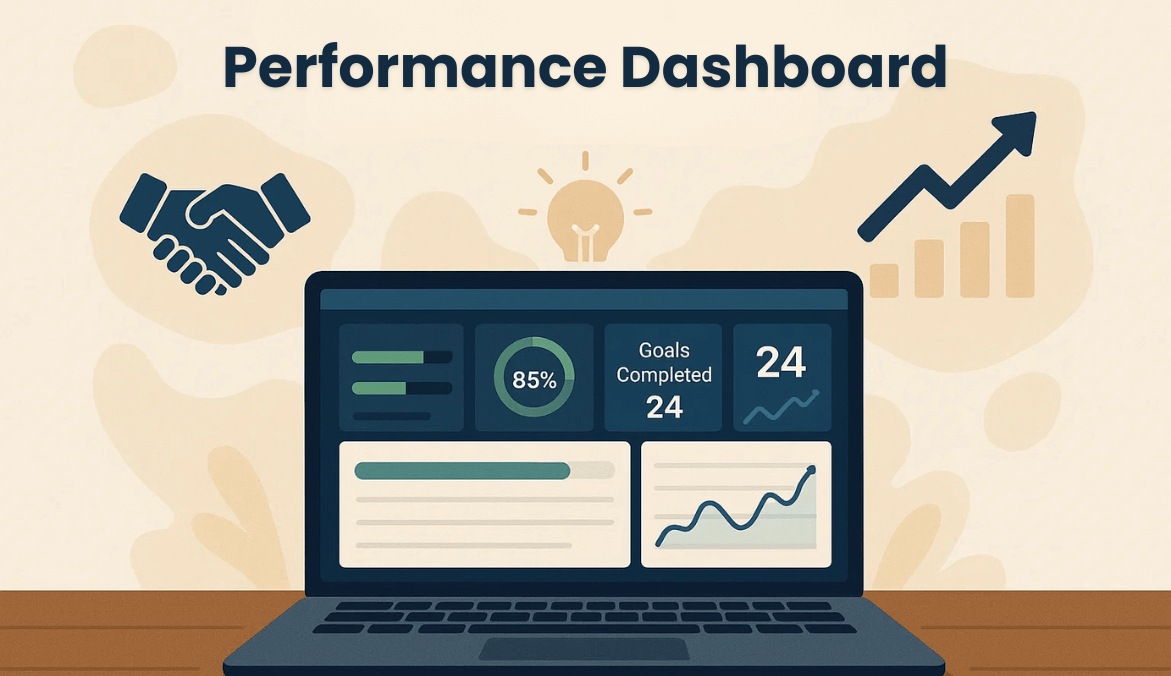Introduction
Let me start with something I’ve learned in 15+ years of leading teams: most people want to do great work. The real challenge isn’t motivation — it’s clarity. Teams lose momentum when they don’t know exactly what success looks like or when performance monitoring feels like micromanagement.
And here’s the kicker: only 20% of employees strongly agree their performance is managed in a way that motivates them. That means most organizations are leaving potential on the table — not because people don’t care, but because monitoring systems are broken.
This article will give you a practical system you can use to monitor team performance without killing morale.
1. Define Success Before You Measure It
Before you jump into numbers, step back and answer one question: “What does success actually look like for this team?”
Objectives and Key Results (OKRs): These set direction. Think of them as your GPS telling the team where to go.
Key Performance Indicators (KPIs): These track ongoing health. They’re the dashboard warning lights telling you if you’re running hot, cold, or right on track.
Real-world insight: In one SaaS project I led, the team tracked KPIs like “tickets closed” and “hours worked.” On paper, performance looked great. But without Objectives and Key Results to define the bigger outcome — reducing customer churn — they missed the point.
Lead vs Lag Indicators
Balance leading indicators (predict future success, like customer onboarding speed) and lagging indicators (reflect past results, like churn rate).
The Balanced Scorecard
A simple way to cover blind spots is using the Balanced Scorecard framework. It reminds you to monitor Financial, Customer, Process, and Learning outcomes. And research from McKinsey shows that companies focusing on employee’s performance are 4.2× more likely to outperform peers, achieve ~30% higher revenue growth, and experience ~5 percentage points lower attrition — proof that a balanced system drives both results and retention.
2. A Practical KPI Library by Team Type
One mistake I often see is teams adopting random KPIs that don’t fit their work. To save you the headache, here’s a KPI starter kit organized by team type:
- Sales Teams: quota attainment, pipeline coverage, win rate, average sales cycle.
- Customer Success Teams: Net Revenue Retention (NRR), churn, time-to-value, CSAT.
- Product & Engineering Teams: cycle time, deployment frequency, mean time to recovery, work-in-progress (WIP).
- Operations Teams: throughput, first-pass yield, on-time delivery.
- HR/Recruitment Teams: time-to-hire, quality-of-hire, ramp-up success.
Pro tip: Map each KPI directly to an Objective and Key Result.
3. Measurement Rituals & Cadences That Work
Metrics alone don’t drive performance — rhythms do.
- Weekly Standups: Focus on risks and blockers — not endless status updates.
- Biweekly Retrospectives: Look at what slowed you down, not who.
- Monthly Reviews: Check trend lines.
- Quarterly Reset: Realign Objectives and Key Results to strategy shifts.
Real-world insight: I once coached a team that turned their weekly meetings into dashboard reviews instead of status calls. Meetings shrank by 40%, and suddenly people had energy left for problem-solving instead of repeating updates.
And the data backs this up: companies that adopt continuous performance feedback outperform their counterparts by 24%. This shows it’s not about more reviews, but the right rhythm of meaningful ones.
4. Build a No-Nonsense Dashboard
A good dashboard is like the cockpit of a plane: it shows what matters without overwhelming the pilot.
Six tiles every team dashboard should have:
- Goal progress (OKR status)
- Throughput (work completed)
- Quality (error/defect rates)
- Predictability (cycle time, on-time delivery)
- Blockers (work stuck or overdue)
- Capacity (workload vs bandwidth)
Quick win: Create different views for executives, managers, and contributors.
Here’s why dashboards matter: Gallup found that employees who receive meaningful, real-time feedback are 80% fully engaged. Dashboards make this possible by turning metrics into ongoing conversations instead of annual surprises — a major shift in how teams stay aligned and motivated.
5. Ethics, Transparency, and Compliance
Monitoring can cross the line if handled poorly.
- Transparency: Always explain what you’re tracking and why.
- Boundaries: Never monitor private areas or personal devices without explicit consent.
- Data Retention: Keep data only as long as it’s useful.
Real-world insight: Early in my career, I saw a company secretly monitor keystrokes. The backlash destroyed trust, and productivity tanked. Later, I learned the opposite is true: Gartner found employee acceptance of monitoring rises when companies are upfront about how and why data is collected.
A Real-World Case: What Good Looks Like in 90 Days
Insight from experience: In one project, a cross-functional team used just three metrics — cycle time, customer satisfaction, and defect rate. By sticking to a weekly review and a monthly retro, they cut cycle time by 25% in 90 days. Morale went up because performance monitoring gave them clarity, not pressure.
🚀 How Mera Monitor Helps You Monitor Smarter, Not Harder
Performance monitoring should feel like a support system, not surveillance. That’s exactly what Mera Monitor delivers. Instead of micromanaging or chasing updates, you get automated timesheets, real-time dashboards, and clear activity insights — giving leaders visibility while empowering teams to self-manage.
With features like active vs. idle time tracking, project-level visibility, and transparent performance dashboards, Mera Monitor connects the dots between effort and outcomes. The result? You spot risks early, align goals faster, and create accountability without killing morale.
💡 Pro Insight: Teams that see monitoring as clarity, not control, are more engaged, more productive, and more likely to stick around.
👉 Start your free trial or book a demo today to see how Mera Monitor turns performance monitoring into a growth engine — without micromanagement.
Conclusion
Performance monitoring isn’t about control. It’s about creating visibility, rhythm, and learning so your team can succeed without being micromanaged.
If you remember one thing:
- Define outcomes with Objectives and Key Results.
- Track a few meaningful Key Performance Indicators.
- Keep monitoring transparent.
- Use cadences and dashboards to make metrics useful.
Start small — pick one Objective, one Key Performance Indicator, and one cadence. Build from there.
FAQs
Objectives and Key Results (OKRs) define the direction by answering “what are we trying to achieve and why does it matter?” They set the bigger picture, like “Increase customer retention by 15% this quarter.”
Key Performance Indicators (KPIs) are the measurable signals that track progress toward those objectives. They answer “how will we know if we’re on track?” For example, churn rate, Net Revenue Retention (NRR), or onboarding completion rate.
The two work best together: OKRs provide the ambition and focus, while KPIs provide the ongoing health checks. Think of OKRs as the destination and KPIs as the dashboard gauges.
The key is to avoid overload. Start with a balanced trio of KPIs:
- One outcome KPI (e.g., Net Revenue Retention for Customer Success, cycle time for Engineering).
- One quality KPI (e.g., defect escape rate, customer satisfaction score).
- One leading indicator (predictive signal, like sales pipeline coverage or onboarding completion rates).
This combination gives you a rounded view: outcome tells you if you’re achieving results, quality ensures work standards stay high, and leading indicators warn of future risks.
Over time, you can expand, but don’t track more than 5–6 KPIs per team — otherwise, focus gets diluted.
Successful teams set up a multi-level cadence:
- Weekly reviews: Focus on blockers, risks, and quick adjustments. These should be short (15–20 minutes).
- Monthly reviews: Zoom out to trends. Are metrics improving or flatlining? Use this time for process tweaks or experiments.
- Quarterly reviews: Reset Objectives and Key Results to align with strategy shifts. Celebrate wins, course-correct misses, and refresh priorities.
Consistency matters more than frequency. Reviews should always end with clear next steps, not just a recap.
The golden rule: monitor the work, not the people. Instead of tracking keystrokes, screenshots, or idle time obsessively, focus on work artifacts — tasks completed, cycle time, quality levels, customer feedback.
Dashboards shared openly with the team build transparency and shared accountability. For example, if cycle time rises, the discussion shifts to fixing process bottlenecks instead of blaming individuals.
This approach empowers teams to self-correct and fosters ownership, while still giving leaders visibility into progress. Monitoring should feel like a support system, not a surveillance system.
Yes — even in a lightweight version. A Balanced Scorecard prevents tunnel vision by ensuring you look at performance through four lenses:
- Financial: Are we creating business value?
- Customer: Are clients satisfied and loyal?
- Process: Are workflows efficient and predictable?
- Learning & Growth: Is the team improving skills and innovation?
Without this balance, teams often chase short-term results while neglecting customer satisfaction or team growth. A simple scorecard with 1–2 KPIs per category can transform how leaders make decisions.
The best tool is one that integrates with your team’s source of truth and reduces manual work. Common options:
- Project management tools (Karya Keeper, Jira, Trello) for tasks and throughput.
- Employee monitoring tools (like Mera Monitor) for time tracking, productivity insights, and activity monitoring.
- BI dashboards (Power BI, Google Data Studio, Tableau) to centralize metrics across teams.
👉 Start simple. A small team might only need a project management tool with built-in reports. Larger organizations may need combined solutions. Whatever you choose, ensure each KPI connects to a decision — otherwise, it’s just noise.
 Gift Card ₹999
Gift Card ₹999

